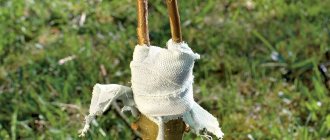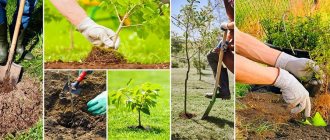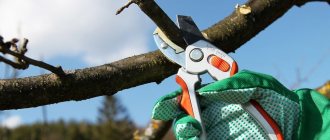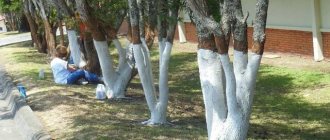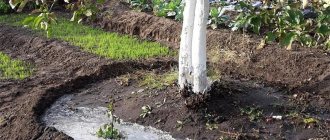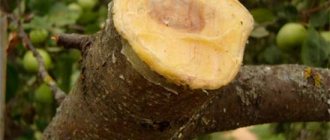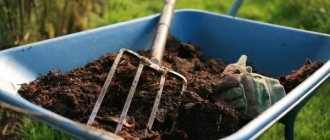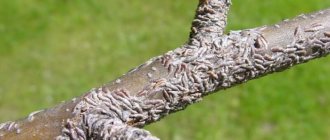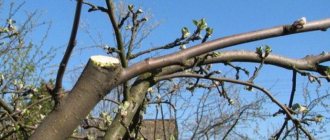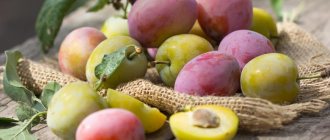What is a vaccination and why is it needed?
Grafting is a vegetative (without seeds) method of plant propagation, when one plant or part of it is grafted onto another.
That part (cutting, bud or branch) that is grafted and carries the varietal characteristics of the plant is called a scion. And the basis on which the scion is grafted is the rootstock. They can be used either by a young plant (wild or cultivated), or an old one, or even a broken one. The rootstock is responsible for the nutrition and growth of the tree and determines its frost resistance.
The main purpose of grafting is to obtain a cultivated plant, since fruit trees do not transmit their varietal qualities through seeds. If you have high-quality wildflowers (seedlings) nearby, grafting your favorite varieties onto them is easier, more reliable and cheaper than buying a ready-made seedling.
To save space, you can graft several varieties onto one trunk at once.
Grafting will help preserve the variety if the old tree is damaged.
This way you can replace a variety you don’t like with a more successful one.
And, of course, in this way you can increase the frost resistance of the crop (for example, if an apricot is grafted onto a plum adapted to local conditions).
Selecting the material
How to choose a rootstock?
- The basic rule: the rootstock must be of the same species as the scion. An apple tree grafts well onto an apple tree, a pear tree onto a pear tree, a cherry tree onto cherries and cherries, etc. It is known that the apple tree also takes root well on mountain ash (and as a result of its “closeness” with other trees, new varieties were obtained), but everything is better -use genetically similar material.
- You need to choose a tree that is healthy and strong.
- The scion and rootstock must be compatible in terms of growth rates.
- It is desirable that the fruits ripen at the same time. Skillfully selected varieties allow you to break this rule without losing results, but this is the path of experienced gardeners.
- If you want to get a columnar apple tree, the rootstock must be appropriate.
- A tree grown from seed is tall, has deep roots, is durable and more resistant to adverse factors. Whereas the clonal rootstock (obtained by cuttings) is not tall, begins to bear fruit earlier and bears more marketable fruits.
How to choose a scion?
- In order for you to be confident in the taste of the variety, the donor tree must be mature and bear fruit for at least 2 years.
- The cuttings must be one year old, healthy, without visible damage to the bark, and have a thin layer of green cambium under the bark when cut.
Required tools and materials
The following tool is used for grafting:
- Secateurs - for cutting cuttings.
- Copping knife - for separating the bark.
- Garden saw - for cutting thick branches.
- Garden knife - for cutting thin branches. Some people use regular stationery instead.
Along with a regular knife, a budding knife is used: it is equipped with a “bone” for separating the bark. In addition, there are combination knives - with two blades on the handle.
Some gardeners advise using several knives: one for cutting branches, a second for making cuts, and a third for applying garden varnish.
Additionally, you may need a flat-head screwdriver (to make a wedge at the split site).
Be sure to have electrical tape or film and garden pitch (resin) on hand.
The tool must be sharp and in good working order. Before each use it must be treated with alcohol.
Grafting fruit trees into a side cut
A technology that is little used in nurseries, but is of interest to amateur gardeners. The grafting is carried out into a rootstock of any thickness and ensures good fusion. The operation is most often performed to improve the productivity of an already fruit-bearing orchard by replacing the top of an old tree.
The work period is winter, spring and summer.
A slit is cut on the side of the tree trunk, tapering downward. A scion with 2 buds is cut on both sides at a bevel to form a sharp edge and is wedged into the notch. Next, tying and plastering with garden varnish are performed.
When can trees be grafted?
Let's look at the question: when can trees be grafted? Vaccinations are available in winter, spring and summer. Each season has its own advantages.
Winter grafting allows you to obtain a varietal one-year-old seedling next fall.
Its main amenities:
- the gardener has more time;
- work is carried out in a warm room;
- survival rate – 97%.
The timing of winter vaccination ranges from December to mid-April. The main thing is to complete the work 2 weeks before planting the seedlings. Preparation begins in the fall: before frost, one-year or two-year-old shoots (you can also use root shoots) with a stem thickness of at least 7 mm are dug up, some of the roots are cut off and stored in the cellar. For the scion, annual shoots are cut from the outer part of the crown, the varieties are labeled and also placed in the cold. 2 days before vaccination they are transferred to a warm place.
Vaccination in the spring is considered the most physiological. It lasts from March to early June, during active sap flow on the rootstock. The scion can be prepared in the fall or cut immediately before the process. For successful fusion, it must “sleep”.
It is recommended to start work when the daytime temperature rises to 10 degrees and the night temperature to zero.
Summer vaccinations have their advantages:
- You can evaluate the condition of the overwintered rootstock and select the best trees.
- Cuttings do not require storage.
- There is time to repeat an unsuccessful attempt.
- The grafted branch tends to produce more lateral branches, which is convenient for crown formation.
The optimal time for vaccination is August. In summer, they are grafted in cloudy but dry weather. Leaves from the cuttings must be removed. It is also important at what time to vaccinate. In hot weather (if it is not possible to wait it out), work is carried out before noon and after 16:00.
Budding of fruit trees
Using this technology, a dormant bud (eye) is grafted.
Budding is the main method of domestication of wild animals used in nurseries. It is faster to implement and more economical: from one cutting you can take 4-5 buds for grafting the corresponding number of rootstocks. The operation is performed during the period of active movement of juice. Tentatively, this is the end of July - the beginning of August, but the exact dates depend on regional climatic conditions. The criterion for their determination is slight peeling of the bark.
Seedlings with branches up to 1 cm thick are suitable for budding. Before grafting fruit trees, prepare the base. All branches are cut off from the bottom of the trunk, leaving 5-7 skeletal branches in different directions in the crown.
Annual shoots in the growth stage with strengthened wood and formed buds are used as scions. Cuttings 10-15 cm long are prepared from their middle part.
Next, cut out the shields - eyes with wood about 3 cm in length and transfer them to the rootstocks. To do this, a T-shaped cut of the bark is made at the grafting site. The shield is placed behind the bark and tied.
Before carrying out the operation, the rootstock trunk should be washed with a damp cloth.
After 1.5-2 weeks, you should make sure that the budding of the fruit trees was successful and the scion has taken root. Otherwise, the operation can be repeated if time permits and the bark is still exfoliating
How to properly prepare cuttings?
A cutting is not just any branch, as it seems at first glance.
To create a good garden, the material must be carefully selected:
- You need to harvest cuttings from a fruit-bearing tree that has shown good yield.
- As a cutting, take a one-year-old shoot with at least two buds (it is better when there are 4 - 5).
- Foliage and bark must be healthy.
- Branches on the outer southern side of the crown, where the light is best, are best suited.
- It is advisable to take material from the middle tier.
- The cross section of an ideal cutting is 6 - 7 mm (like a simple pencil).
- In spring, the buds on the cuttings should sleep.
- If you are going to graft in the summer, it is better to cut the scion on the day of grafting and use it within 3 hours.
- In winter, cuttings must be checked for viability. Make a small cross-section: if there is a green layer under the bark, the cutting is alive.
Grafting trees in spring butt
It is needed to prevent the death of a young tree eaten by mice, damaged by sunburn or stripped when processed with tools. In case of extensive damage, so many bridges are placed so that the distance from one to another does not exceed 3 cm. Fused bridges connect separated sections of the bark of the trunk or branches and provide recharge and water supply to areas of the tree located above the site of damage.
At the ends of the cuttings, beveled cuts are made on one side with a knife - the same as with the “bark” grafting method. Before inserting the bridges, the edges of the wound are cleaned, longitudinal cuts are made at the top and bottom, and the ends of the wood-to-wood cuttings are inserted into them under the bark. It is important that the cutting is slightly longer and springs a little after insertion into the cuts. The inserted cuttings must be tied tightly at the top and bottom with twine, you can even nail them with thin nails and cover them with soft garden putty.
Vaccination methods
There are several methods of vaccination:
- Vaccination for the bark.
- Vaccination at the drop of a hat.
- Cleft grafting.
- Copulation.
- Ablactation.
- Budding.
The choice depends on the size of the tree, climate and season.
For the bark
This method is used when there is a significant difference in the thickness of the rootstock and scion. The timing of vaccination is from the beginning to the active stage of sap flow.
The rootstock is pruned to fit the stump. As a scion, dormant or awakening cuttings are used, cut to 2 - 3 buds. The lower part of them must be cut at an acute angle to obtain a cut 2.5 - 3 cm long. An incision of the same length is made on the stump, then the bark is carefully separated with a special knife, after which a scion cutting is inserted there. The place of fusion is tied and treated with garden varnish.
For better survival, a horizontal incision is made on the cutting along with an oblique one - the so-called saddle, with which the scion “sits” on the stump.
In total, you can “plant” 2 – 3 shoots on a stump.
Video instructions are below.
In the end
Produced into rootstock of any thickness. It is mainly used to renew the crown of an old tree. This method can be planted in winter, spring and summer.
A slit tapering downwards is cut out on the side of the tree, into which a scion cut into two buds and cut on both sides along an oblique side is wedged. After this, the plant is tied and treated with garden varnish.
More details in the video below.
Into the cleft
Used for trees with rough bark or damaged by unsuccessful grafting. The easiest and best way for a beginner. They are grafted into the cleft before sap flow begins.
The rootstock is cut down under the stump and trimmed with a garden knife. Then a gap is made in it and a temporary wedge is inserted. The scion is a branch with 5 buds, cut on both sides at an angle and inserted into the gap, after which the wedge is removed. If the rootstock is much thicker, insert a cutting on each side. The plant does not need to be tied, as a natural clamp is created. At the end, all open areas are treated with garden varnish. More details are shown in the video.
Copulation
The copulation method is used on a thin rootstock when it is impossible to graft behind the bark. It allows you to cultivate very young seedlings without waiting for the trunk to strengthen. Copulation is carried out when the trees are dormant: in winter or spring before sap flow begins. For winter grafting, trees must be dug up in the fall and planted with the scion in the spring.
Normal copying is done like this. The scion is shortened to 2–3 buds. Equal oblique cuts are made on the scion and rootstock. Then the sections are applied to each other and wrapped with electrical tape. If the branches match in thickness, the scion is placed on top. If the rootstock is much thicker, the scion is placed on the side so that the bark and cambium layer coincide - in this case, up to 3 cuttings can be grafted.
The method of improved copulation consists of adding a “tongue” to the cut - an additional cut on both branches. “Tabs” allow for a stronger grip and better retention in the future. If we graft onto a stump, we also make a “saddle” during copulation.
Here is a video on how to do copulation.
In addition, summer copulation with green cuttings is possible. This refers to the leafy parts of the stem with several buds. The cutting is planted on an unrooted rootstock, and then the resulting plant is rooted in conditions of high humidity or artificial fog. The method is most often used for grapes and flowers, but can also be used for fruit trees.
Ablactation
It consists of merging two plants, i.e. the scion is not a cutting, but a living tree or shrub. The thickness of the plants may be similar or different. The entire growing season is suitable for work, but the best time is spring.
This method is mainly used for garden decoration. It allows you to fill the required area and close voids - especially when it comes to creeping forms. Also, using ablactation, you can give the plant additional nutrition from another root.
Ablation of plants of similar thickness is done butt-to-shoulder (with oblique cuts towards each other, you can cut out “tongues”). If the rootstock is much thicker, its bark is cut off and a scion is placed there. The fusion site is bandaged.
Ablation using the example of citrus grafting.
Budding
Kidney grafting, i.e. budding, is the most common type of grafting. The scion for grafting is a single bud, which gardeners call an “eye.” It is taken from the shoot of a cultivated plant and grafted onto a branch or trunk of another variety or wild game.
Spring budding is carried out with a bud formed last summer. For this purpose, cuttings are prepared in the fall or at the end of winter. Already in the same season, the bud will begin to germinate and give rise to a new shoot.
If the grafting is carried out in the summer with a freshly cut bud, then it will take root, overwinter and begin to grow only next spring.
Video about the features of summer budding:
Vaccination dates
Vaccinations can be carried out from spring to autumn, but the most suitable period for this procedure is from March to the end of May. At this time, active sap flow begins in the trees, accelerating the engraftment process. And the scion, that is, the varietal cutting that is grafted onto the game, must be at rest at the time of the procedure. Both the seedling to which the varietal cutting will be grafted and the scion must be developed and healthy. Compliance with these conditions is the key to the success of the procedure.
If the grafting is planned to be carried out in spring or winter, cuttings for it are prepared in advance - in the fall, after the leaves fall, but before the onset of frost, or, in extreme cases, in the spring, but before the sap ferments in the trees. For summer grafting, scions with a woody base are cut off right before the procedure.
Stone fruit trees - cherries, cherries, plums, apricots or peach - are best planted in March or April, and apple, pear, quince and other pome-bearing trees - 2-3 weeks later.
- Goji: cultivation, properties, types
Is it possible to graft conifers?
Grafting coniferous trees and shrubs is not only possible, but also effective. With its help you can plant a large number of ornamental plants in the garden.
Conifers are grafted in spring and autumn (August - September is recommended). Copulation is most often used.
The basic rules are the same as for fruit plants: healthy plants of the same species are selected, cuttings are stored for no more than 2 weeks, and work is carried out as quickly as possible.
There are also differences:
- It is better to cut cuttings from the top tier;
- The optimal air temperature at the time of vaccination is + 15 + 22 degrees. In areas with a cool climate, a bag must be placed on the plant.
An important point: all the needles are removed from the scion, leaving only the top. The appearance of new needles is an indicator of success and a signal that it is time to remove the package.
Ablation of fruit trees
Ablation or proximity grafting is carried out by merging plant branches through sections of bark or wood. This technology has found applications in molded gardening. It makes it possible to renew the crown, replace damaged areas and fill voids, as well as form slate (creeping) forms.
Ablactation allows you to plant trees in limited spaces, for example, near the walls of a house, where they, using the vertical area as efficiently as possible, not only produce a good harvest, but also perform a decorative function. The technique is also used to save trees that are sick or eaten by animals, providing nutrition to the crown from another root.
The operation can be carried out throughout the growing season, but spring is considered the best time.
If the diameters of the rootstock and scion match, produce the usual butt of branches cut lengthwise by 5 cm. The splice area is wrapped and sealed. For better splicing, tongue hooks can be made.
If the rootstock is thicker, then the bark on it is only trimmed and the scion is inserted into the slot.
In conclusion, we suggest watching a video about methods of grafting fruit trees in the spring.
Tricks and wisdom of a gardener
These tricks and wisdom from professionals will help improve the results of vaccination work:
- An even cut of a cutting is a test for novice gardeners. In addition, you need to make the cut correctly at one time. Therefore, before gardening work, it is advisable to practice on pear branches: they have hard wood.
- A good garden varnish should soften in the sun without heating.
- Use a special, sharp, serviceable tool, treated with alcohol.
- Before work, rinse the cuttings with water and keep them in a damp cloth.
- Avoid prolonged contact of the grafting material with air and do not touch it with your hands.
- Sections of bark and cambium on the scion and rootstock should match as much as possible.
- The longer the cut, the more successful the fusion is.
- At the bottom of the scion, it is recommended to remove 0.5 - 1 cm of bark to increase the area of fusion.
- It is advisable to have a healthy bud above the scion cut, as this stimulates the development of the branch. In addition, if the cutting breaks, a new varietal shoot can be grown from this bud.
- It is advisable to treat not only the end of the rootstock with garden varnish, but also the upper cut of the scion. This reduces evaporation, thereby ensuring better survival. In addition, you can put a bag on the site of fusion. Bud break will indicate when the bag can be removed from the graft.
- A tool for separating bark can be made from a regular 100-millimeter nail. To do this, you need to sharpen it to half the thickness and 2 cm in length, and then sharpen the tip.
- If you tie several sticks to the graft, rising above the graft, this will protect the escape from birds that like to perch on the wrapped branches.
Grafting trees into clefts in spring
If the diameter of the rootstock is too large, split grafting is used. First, the rootstock is cut at the grafting site so that a smooth surface is obtained. It is recommended to cut a large scion 2 cm above the selected location. The roughness of the cut means that the cut needs to be made slightly lower than the previous cut. Next, take a sharp tool and split the rootstock, sticking something into the split as a spacer. When installing the scion, the parent layers must be aligned. There is no need for tying, since the split is held by the scion. The copulation site is lubricated with wax to prevent it from drying out.
Latest articles for gardeners, gardeners and flower growers
How to plant a mango seed at home
How to plant an avocado seed at home
Tomatoes Puzata Khata variety description photo reviews
When to plant tomatoes for seedlings in 2021 according to the lunar calendar
Planting grafted seedlings
Grafted trees are planted in the ground in the same way as ordinary ones. Here we will only touch on issues related to vaccination.
There are different opinions on why you should not bury the graft in a seedling. The most harmless thing: the scion forms roots, which reduces the winter hardiness of the plant. They also write that the vaccine will die out. The most correct answer: the graft is located above the root collar. Therefore, if the grafting is deepened, the root collar will be covered, and this will lead to the death of the tree.
In which direction the tree is grafted does not matter much. One has only to pay attention to the location of the skeletal branches of the seedling. They need to be directed to the north or northwest, since in the future the main development of the branches will come from the south.
Let your garden grow strong and healthy! Subscribe, we will help you with good advice.
